If that wasn’t enough, it now faces perhaps the biggest battle of all – against the sea itself. The shingle beach is eroding. The ocean has crept so close it’s barely ten metres from its door. The lighthouse is at risk of tumbling into the North Sea.
I’ve been fascinated by this place ever since my first visit in 2004. I was very lucky to see the lamp while it was still working and run by Trinity House, the organisation that runs 69 lighthouses around our coast. It fired my imagination … Although Jack’s lighthouse sits on its own rocky island in a fictional location, it’s fair to say that the building was inspired by Orfordness.
Rugged and remote, it’s a big adventure just getting there. The village of Orford lies hidden away at the end of a country lane that leads to a tiny quay on the River Ore. It’s a short ferry ride to the other side and then a forty-minute hike across an eerie landscape that’s dotted with strange derelict buildings.
In days gone by you’d have found yourself in big trouble if you tried going there. The land used to be owned by the Ministry of Defence. It was one of the few sites in the UK with facilities for secretly testing the components of nuclear bombs.
These days it’s a National Trust nature reserve. Even so, you have to keep on the tarmac road. And not just to avoid disturbing the fragile wildlife habitat. There are signs warning of unexploded shells!
Access is strictly controlled. The Ness is only open on certain days. Military debris litters the route, the birds screech and the wind howls across the salt marsh. It feels a bit like the end of the world has arrived – especially now the light inside has been dismantled. Sadly, the lighthouse had to be turned off in 2013.
The plan was to let nature take its course and allow the building to fall into the sea. Then a London lawyer with a home in Orford bought it for £2000 and a charity, the Orfordness Lighthouse Trust, was set up.
Thanks to the Trust the lighthouse opened to the public with the aim of allowing as many people to visit as possible while it still stood. Along with others, I made another pilgrimage last year and thought it would be my last. Big seas and strong winds were eating away at the shingle. It seemed just one more storm might overcome the temporary defences the Trust had worked so hard to put in place.
Then last winter delivered a reprieve. The storm surge that looked like it would wreak havoc ended up dumping more shingle on the beach, shoring up the defences.
Lydia Finney of the Trust told me: ‘The defences have worked extremely well and, with the past winter having been kind to us, we have been able to open to the public again this year. We shall review the situation winter by winter and in the meantime hope we can keep her standing where she is, and open the lighthouse to the public, for as long as possible.’
The story goes on. And it is a tale of hope …
About Orfordness Lighthouse
The present lighthouse is 30 metres high, has four flights of stairs and 100 sturdy steps. Built in 1792, it was designed by the architect William Wilkins.
When in operation the huge 4 ton rotating lens made one full rotation every 15 seconds and flashed once every 5 seconds. Its beam could be seen 27 miles away.
The original lighthouse was built after the great storm of October 1627 when 32 ships were wrecked nearby. The hazards to shipping were the Aldeburgh Ridge and the Sizewell Bank. Boats needed to find their way between them.
The lighthouse is called Orfordness while the National Trust land around it is known as Orford Ness.
News links:
You can read more about visits to the Orfordness Lighthouse here.







 Buy The Mirror Of Pharos from the Author
Buy The Mirror Of Pharos from the Author